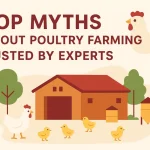Sheep farming has emerged as one of the most profitable, sustainable, and manageable livestock ventures across the globe. Whether you’re looking to raise sheep for meat, wool, or milk—or you’re simply interested in building a self-sustaining farm—starting right is key.
This beginner-friendly guide gives you 8 practical and proven tips to help you launch a successful sheep farming business with confidence.
1. Start Small and Build Slowly
Table of Contents
ToggleJumping into commercial sheep farming without hands-on experience can lead to costly mistakes. The best approach is to start small—with 10 to 20 sheep—so you can learn the basics of daily care, feeding, disease control, and farm management firsthand.
Small herds help you:
- Manage costs
- Avoid being overwhelmed
- Monitor individual animal health easily
- Scale only when you’re confident
As your skills grow, you can expand your flock into a commercial operation with much greater efficiency and fewer surprises.
2. Select the Right Breed for Your Purpose
Sheep come in various breeds, each suited to different purposes like meat, milk, or wool. Your success will depend heavily on choosing breeds that match your climate, market demand, and business goals.
Here’s a quick breakdown:
- Meat Breeds: Dorper, Suffolk, and Dorset are fast-growing and ideal for mutton production.
- Wool Breeds: Merino and Rambouillet offer high-quality fleece for textile markets.
- Dairy Breeds: East Friesian and Lacaune produce rich milk used in cheese and yogurt production.
Make sure to buy from trusted breeders and inspect the animals for health, genetics, and vaccination history.
3. Design Proper Housing and Fencing
Good infrastructure is essential to keep your sheep healthy, safe, and productive.
Housing:
- Keep it dry, clean, and well-ventilated
- Protect from rain, extreme cold, and predators
- Use bedding such as straw or sawdust to maintain hygiene
- Provide space—at least 1.5–2 square meters per adult sheep
Fencing:
- Use high-tensile or woven wire fencing
- Minimum 4-foot height to prevent escape
- Regularly check for damage
Fencing not only prevents theft and predator attacks but also helps manage rotational grazing.
4. Understand Feeding and Nutrition
Feeding your sheep right is the most critical factor in ensuring healthy weight gain, reproduction, and wool/milk quality.
Basic Diet Includes:
- Pasture Grazing: Natural grasses, legumes
- Hay: Essential during dry seasons
- Concentrates: Grains like corn or oats during breeding, lambing, or illness
- Minerals: Provide a salt lick and mineral blocks
- Clean Water: Always fresh and available
Adjust feeding based on the sheep’s age, stage (pregnancy, lactation), and weather. Overfeeding grains can cause bloating, so balance is key.
5. Set Up a Breeding Plan
Breeding management is crucial for flock growth and profitability. Sheep typically breed once or twice a year with a gestation period of approximately 5 months.
Tips for Effective Breeding:
- Select healthy, proven rams and ewes
- Plan for lambing seasons to coincide with good weather and pasture availability
- Maintain breeding records (dates, parentage, number of lambs, survival rate)
- Separate pregnant ewes for closer care during lambing
Good breeding practices help increase lamb survival, improve genetics, and grow your flock faster.
6. Implement Health and Disease Control
Even one sick sheep can impact your entire flock. Early prevention, observation, and action are key.
Common Diseases:
- Foot rot
- Internal parasites (worms)
- Pneumonia
- Enterotoxemia
Best Practices:
- Vaccinate on schedule
- Deworm regularly and rotate pastures
- Clean shelters and water troughs
- Inspect hooves and trim when necessary
- Isolate any sheep showing signs of illness
Establish a connection with a local veterinarian and keep medical records for every animal.
7. Know the Local Market
Before your first lamb is born, understand where and how you’ll sell your products. Your options include:
- Live animals for breeding or slaughter
- Processed meat for butcher shops or restaurants
- Raw wool or fleece for textile manufacturers
- Milk or dairy products for niche markets
You can also explore farmers’ markets, direct-to-consumer sales, or even online marketplaces. Build a marketing strategy early so you’re not scrambling later.
8. Practice Sustainable and Ethical Farming
Sustainable sheep farming not only benefits the environment but also helps your bottom line.
Key Sustainability Practices:
- Rotational grazing to allow pastures to regenerate
- Use manure as natural fertilizer
- Integrate sheep with goat or poultry farming to diversify risk
- Use solar-powered water systems where possible
By focusing on animal welfare, soil health, and responsible farming, you build a long-term business that supports both your livelihood and the ecosystem.
Final Thoughts
Sheep farming is more than just putting animals on a field—it’s a structured, rewarding business when approached with planning and passion. From selecting breeds to maintaining herd health and marketing your products, each step plays a role in your success.
By following these 8 practical tips, you’ll be better equipped to launch your sheep farming journey with clarity and confidence. Need help getting started? Visit Sheep and Goat Farming to explore quality livestock, training, and expert support tailored to your goals.
Also Read: How to Start Goat Farming in India (2025 Guide)
















